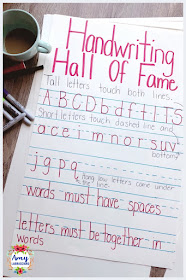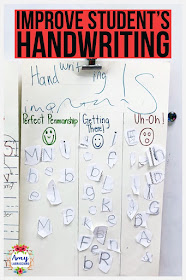How is your student's handwriting doing? If it's anything like I've seen we have a lot of work to do. Over the years I've noticed that the more students are on hand held devices and inside, the worse their handwriting gets. I think it's because they don't increase their fine motor skills the way they would if they were outside, doing arts and crafts and working out their entire hand versus just their thumbs.
I've see improvement with students every year when I do the following.
1. Set expectations. Tell them you expect that their work is written neatly and hand it back when it's not. You don't want to badger or stress students out, but you do want to encourage them to work towards a goal of better penmanship by improving on assignments.
2. Spend a couple weeks going over lessons on how to properly form letters. If students have forgotten or don't know how, they will need your help. I know you don't have time to do this, either do I. However, a couple of weeks now will save a year's worth of headaches from trying to figure out chicken scratch.
3. Implement a routine where you consistently praise students for good penmanship and hand back work for improvement. We implement a handwriting hall of fame in my classroom. Once students work is continuously legible, they get to sign the hall of fame poster and receive a special pencil. If their handwriting falls short after wards they are taken out of the hall of fame. Everyone still in the hall of fame at the end of the years receives another pencil. It really isn't time consuming. Just two rewards for the entire year. The poster stays up all year. Every day when we share our writing, I give a quick compliment to those with nice penmanship and congratulate them for staying in the hall of fame. If writing becomes illegible again, I speak to the student privately and tell them to work at it more. It's very important that you understand I'm not expecting perfect writing. I just want to be able to read it. You do not want to stress children out. Just encourage them to do better.
I have a specific lesson plan that I follow when I launch my expectations for penmanship. The first thing I do is explain the chart below to students. I tell them expectations for letters touching lines and provide them with a nameplate on their desk with the alphabet to reference.
Once we go over letter expectations we practice forming our letters with nice clean lines. I used sheets from A Is For Apples to practice forming letters with clean lines. I show the students the anchor chart header below and ask them to read it with me. Of course they can't read it and we have a conversation about why good handwriting is important while we have a few laughs. When we were done, we cut up our letters and sorted them into categories as seen below. This way students took part in making an anchor chart that they felt confident about. It also put the responsibility of assessing their work on them.
Once students have practiced their letters, we implement handwriting bell work. I got these write and wipe sheets from Adventures Beyond Kinder. Students grab the sheets when they are done with their morning procedures and practice handwriting. They can also grab them when they finish work early. Students can earn mini erasers for exceptional work. This practice helps to build their hand muscles and skills.
Once we are done discussing letter formation, we move on to the bottom of the chart listed first on this post and discuss spaces between words and no spaces between the letters within the words. As the year progresses we move on to capital letters at the start of sentences as well as proper nouns. It would be way too much for young students grade k-2 to discuss this all at once. When this time comes, I introduce students to our writing offices. The writing office has charts to help students with capitalization, spelling and reference. You can find my writing office below.







